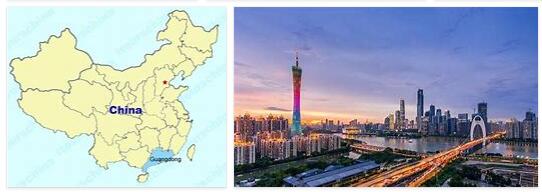Guizhou Province
Guizhou [gwe ɪ d ʒ ɔ u], K Weichow, Kweitschou, province in southwest China , 174,000 km 2, (2010) 34.7 million residents, including national minorities such as Miao, Yao, Bai, Tujia, Buyei, Dong and others, which make up around 36% of the population; The capital is Guiyang. The province comprises a high plateau crossed by mountains (up to over 2,000 m above sea level) with a mild and humid climate and a rich tree population. 150 km southwest of Guiyang, the Baishui Jiang overcomes nine rock steps through waterfalls over a distance of about 2 km. Due to the permeability of the limestone (around 70% of the area), the cultivated land is largely limited to the valleys and basins close to the groundwater. The main crops are rice, wheat and maize, as well as rape, potatoes and tobacco; also silkworm breeding (around Zunyi) and tung oil extraction. Guizhou is one of the poorest provinces in the country, and its industrial output remains low. The most important mining products are mercury, coal and bauxite as well as manganese ores (at Zunyi). The iron and steel, mechanical engineering, electrical, wood, Guizhou’s tobacco and chemical industries are mainly located in Guiyang and Zunyi. There are railways to Sichuan, Yunnan, Guangxi Zhuang.
Guiyang
Guiyang [gwe ɪ ja ŋ ], Kweijang, capital and economic center of Guizhou Province, China, 4.32 million residents in the entire administrative area, of which 2.5 million residents in the city districts; University (founded 1958), TU, technical colleges for agriculture and medicine; Provincial Museum. Rapid industrialization since the completion of the railway connections to the neighboring provinces in the 1950s and 60s: steel works, aluminum smelting (based on the bauxite deposits north of Guiyang), mechanical engineering, food, cement, chemical, car tire and textile industries; Transport hub, airport.
Hainan Province
Hainan, tropical island off the coast of southern China, as a province of 34,300 km 2, (2010) 8.7 million residents (of which about 16% Li and others), the capital and main town of the island is the port city of Haikou. Separatedfrom the mainland (Leizhou peninsula) by the 28 km wide Hainan Strait, Hainan is mountainous in the central and southern parts (Wuzhi Shan 1,867 m above sea level); rich natural resources. Until the 1950s, almost a third of the island was covered by tropical rainforest; By expanding cultivation (wood, sugar cane, coffee, coconut palms, rubber and fig trees, pineapples, bananas; three rice harvests per year), the forest has since shrunk to around 2,000 km 2. Mainly iron ore is extracted from the numerous ore deposits and partly smelted on Hainan; Salt marshes, fishing; Air force and naval base; China’s southernmost spaceport in Wenchang. In recent years, tourism has become the leading industry in Hainan, especially in the south of the island near the city of Sanya.
In 1988 the island was elevated to a province as well as a special economic zone and since then has developed from one of the poorest regions of the country, which was characterized by agriculture (around 69% of the total production value), to the largest special economic zone in China. Since 1988, Hainan has had the opportunity to make greater use of foreign capital through tax breaks. With the completion of the port and on the basis of the so-called Hainan Yangpu economic development zone, in particular electrical, biopharmaceutical, metallurgical, lightwave optical or chemical products will be manufactured.
Guangdong Province
Guangdong, Kwangtung, province in southeast China, on the South China Sea, upstream are the special administrative zones Hong Kong and Macao, 197 100 km 2 with (2010) 104.3 million residents, including national minorities such as the Zhuang and Yao and the independent Chinese Hakka.
- Visit PAULSOURCING.COM for 10 useful tips on sourcing products from China.
The capital is Guangzhou. Guangdong is a mountainous area shielded by mountains of almost 2,000 m in the north from the Yangtze Valley (around two thirds of the area) with plains in the mouth of the Xi Jiang and on the Leizhou peninsula. The province also includes the island groups in the South China Sea claimed by China. Tropical to subtropical climates allow two to three rice harvests a year; also cultivation of sugar cane, citrus fruits, bananas, pineapples, tea, tobacco, peanuts and lychee. Fisheries play a major role in the South China Sea and in numerous farms. Guangdong has a diversified economic base and is currently one of the leading light industrial centers in China (electrical engineering, shoe, textile industry). With high economic growth, the province generates 11% of the gross domestic product with 8% of the total population of China (2010: 44,070 ¥ uan per capita, China on average: 30 010 ¥ uan) and occupies the leading position in China’s foreign trade. In the three industrial areas of consumer goods, electronics and petrochemicals, Guangdong provides two thirds of the national production. High technology, pharmaceuticals and the automotive industry continued to develop. In the service sector, logistics and telecommunications in particular are being developed alongside the constant expansion of the infrastructure. On the coast are the Shenzhen, Zhuhai and Shantou Special Economic Zones for foreign investments. In the service sector, logistics and telecommunications in particular are being developed alongside the constant expansion of the infrastructure. On the coast are the Shenzhen, Zhuhai and Shantou Special Economic Zones for foreign investments. In the service sector, logistics and telecommunications in particular are being developed alongside the constant expansion of the infrastructure. On the coast are the Shenzhen, Zhuhai and Shantou Special Economic Zones for foreign investments.
Why Source from Guangdong?
Guangdong Province, situated in the southeastern part of China, stands as a beacon of economic prowess and industrial dynamism. Renowned as the “Factory of the World,” Guangdong plays a pivotal role in global trade and manufacturing, offering a diverse range of products and services to markets worldwide. When you decided to buy from China, consider a China purchasing agency.
1. Manufacturing Hub: The Heart of China’s Industrial Sector
Guangdong is synonymous with manufacturing excellence, boasting a vast network of factories and production facilities that churn out a staggering array of goods. From electronics and textiles to machinery and toys, Guangdong’s manufacturing prowess spans multiple industries, driving economic growth and development both domestically and internationally.
2. Strategic Location: Gateway to International Trade
Situated along the Pearl River Delta, Guangdong enjoys a strategic location that facilitates seamless connectivity with global markets. Its proximity to major shipping lanes and international ports, including Shenzhen, Guangzhou, and Hong Kong, positions Guangdong as a vital gateway for international trade, enabling efficient logistics and supply chain management for businesses around the world.
3. Innovation and Technology: Fuelling Future Growth
Guangdong’s commitment to innovation and technology is driving the province towards a knowledge-based economy. With thriving technology hubs such as Shenzhen, known as China’s Silicon Valley, Guangdong is at the forefront of technological innovation, spearheading advancements in areas such as artificial intelligence, biotechnology, and renewable energy.
4. Skilled Workforce: Nurturing Talent and Expertise
Guangdong’s workforce is renowned for its skill, diligence, and adaptability. The province’s robust education system, coupled with extensive vocational training programs, ensures a steady supply of talent across various industries. This skilled workforce is instrumental in maintaining Guangdong’s competitive edge in the global marketplace.
5. Business Environment: Supportive Policies and Infrastructure
Guangdong offers a conducive business environment characterized by supportive government policies, modern infrastructure, and streamlined administrative procedures. Foreign investors benefit from preferential policies aimed at encouraging investment and fostering innovation, making Guangdong an attractive destination for business expansion and collaboration.








